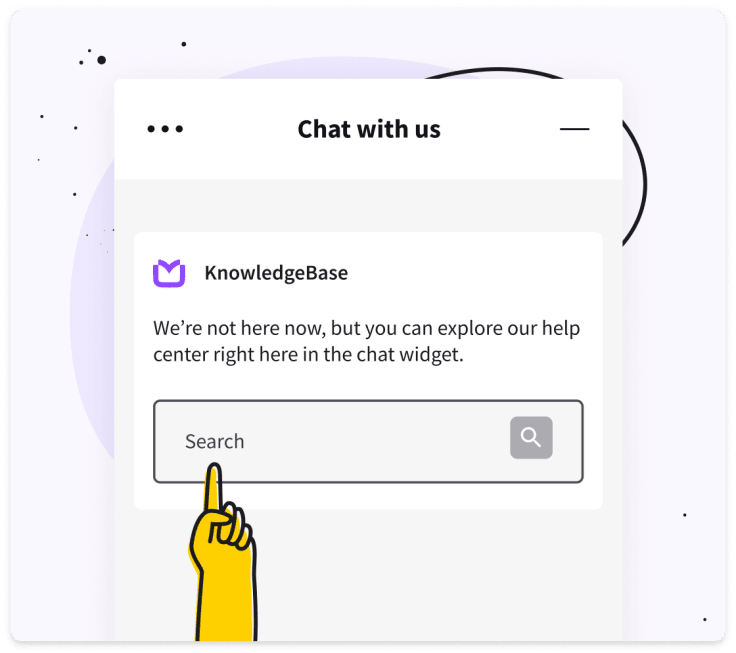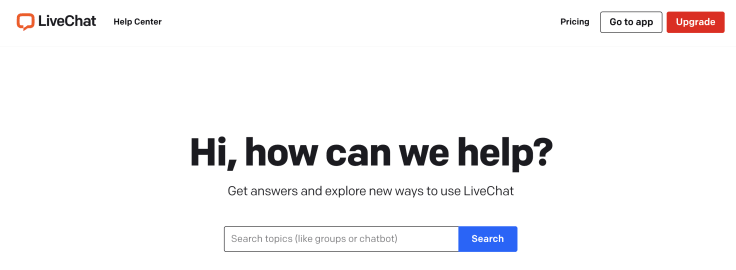
If you already have the idea of building a knowledge base, you’re halfway there. In this article, you’ll find everything you need to turn this idea into an effective knowledge base: tools, best practices, step-by-step instructions, examples, and more.
Customer experience (CX) is a product. It can make or break your sales, customer retention, and a position on a market, even if your product is good. Therefore, customer experience is just another area of competition between businesses.
Of course, CX means a lot, but one area you can surely start improving right here and now is customer self service. As generations come and go, people become more and more tech savvy and feel confident with serving themselves. Generation Z, which is soon to become a dominant segment of consumers, prefers solving issues on their own, contrary to other, older generations.
According to GrooveHQ research, 91% of customers in the US said they would use an online knowledge base if it was tailored to their needs. When a company makes it easy for clients to find information and support, 55% of those consumers become loyal to the brand. In other words, by reducing customer effort, you will improve loyalty as a whole.
The sooner you get your knowledge base up and running the better.
Creating a good help center is no easy feat. It takes some effort, should be an ongoing process, and requires active participation of your team members. This article will guide you through the process.
Does your business actually need a knowledge base?
Whether you’re a small or a large business, you are always doing some kind of customer service, or storing information you use to solve client problems.
Knowledge base software benefits both your organization and the experience of your customers requesting support.
Smaller workload
When customers go to a knowledge base app to resolve issues, the likelihood of them submitting tickets for basic problems decreases significantly. Fewer tickets mean less work for agents and more time for addressing urgent requests.
One good solution to decrease the workload of your team is to offer a live chat knowledge base.
Frictionless support
A knowledge base offers probably the smoothest support there is, because there are no risks connected with an interaction with a support agent. There can be plenty of risks: different time zones, missed tickets, slow responsiveness, beginner agent, or more.
Day and night support
A knowledge base is out there 24/7 which means that customers can look for answers anytime they want and are independent of the working hours of a support team.
Multi-device support
Convenience is important. Users can access your knowledge base with any operating system and device they prefer. There are no constraints when it comes to accessibility.
Faster responsiveness
Responsiveness is key to effective customer support. With a quick reply and easy access to a knowledge base, agents can provide answers rapidly and decrease the average response time.
Operational cost reduction
A self-service knowledge base cuts down costs connected to repetitive queries. Support automation also helps to lower the number of support agents you need to hire and pay.
Knowledge alignment
Creating and maintaining your help resources ensures that the knowledge is unified, and company communication is consistent. It also helps to avoid silos and tribal knowledge.
It’s a different thing if you’re a newborn start-up. In this case, human-to-human customer support is vital for product development.
Businesses at early development stages shouldn’t bother too much about scaling their support and allowing customers to self serve. The early stage of a business is about getting first customers, improving a product or an offer, discovering pain points, and honing relationships with these few customers. Their opinions can be formative.
Automating your support with a self-service knowledge base at an early stage would deprive you of the precious 1-on-1 conversations. They let you get closer to your customers and understand their needs better. It often happens that first customers are more willing to share their thoughts. It’s simply because they’re enthusiastic about a product and want to help.
Tools
It's time to choose a knowledge base tool that fits your needs best. There are a lot of applications to choose from. It’s a good moment to keep in mind what makes good knowledge base software.
Powerful search
One of the fundamentals of great user and customer experience is an effective search bar. Finding information is the key purpose of a knowledge base, so search should work smoothly. Choose a tool that provides search recommendations even after entering a few letters, or words. In this way, users who might not know niche terms, get recommendations and are able to find their solutions.
Knowledge management features
This mostly means tools that allow you to structure your knowledge resources. There should be at least an option to create categories, so navigating around your knowledge resources is easy. Some tools also have other distinguishing features, such as topics or keywords. These can come in handy when you want to group together similar articles, highlight key points for customers, or showcase the most important help articles.
Text editor
Another key feature of a good knowledge base is a text editor. Make sure you like it, because using it will become your bread and butter, and you don’t want to get frustrated with an unintuitive tool. A good text editor should support rich media, such as images, videos, and GIFs. The more media formats it supports the better. Plain text knowledge base articles can be daunting, so adding a little bit of media will surely improve the reading experience of your readers.
Analytics
Effective knowledge base reports will tell you what people are searching for and not finding, giving you ideas for the content you need to add to your knowledge base. Reports can also tell you whether or not your articles are giving people the information they need with satisfaction scores. With this data you are able to optimize your help articles when needed and improve customer satisfaction.
When it comes to tools, you can learn more about the six best knowledge base platforms.
I’m going to eat my own dog food, but if you’re looking for an affordable and simple-to-use knowledge base, I recommend KnowledgeBase.
Here’s a quick overview of the tool.
You can try it out for free for 14 days.
Creating your knowledge base step by step
Once you have your tool of choice, you can get down to building your knowledge base. Building and managing a knowledge base is a never ending process. It happens one step at a time.
However, there are some aspects you need to take care of first that lay the foundation for the future development of your knowledge base.
Design
People judge a book by its cover, which brings us to the design of your knowledge base.
In most tools, you can customize the design of your knowledge base so that it matches your branding. You can pick colors, choose a logo, a unique URL, or sometimes even design the layout of your help center.
This shouldn’t be overlooked. Visual consistency with your brand is an important part of customer experience as it gives a visitor the feeling that they know where they are.
Establish structure
There’s no need to go big from the start.
Pick your categories carefully. You might want to start with broad categories and then create subcategories later on, as you add more articles. It’s good to begin with topics that bother customers the most. There are two ways to discover them.
You can talk with the people on the front line – your customer support agents. If you already have a support team, they know the most frequent customer problems by heart. It’s possible that your agents already have an FAQ document with questions and answers, so it’s even better. I’m sure they will happily share them in the name of a lower workload.
If you don’t have a team, you need to investigate it yourself. Go through your social media channels, private messages, emails, and collect all the questions.
This will give you an idea of the areas of your business that your customers have problems with. They should become your backbone categories. They're the simplest to answer because there's no gray area. Your price is your price, your return policy is all up to you. Some of the categories that concern all kinds of businesses include:
- Billing
- Returns and refunds
- FAQ
Most knowledge base software offers analytics which track trends in customer support requests. This feature can give you some valuable insights into the most frequently asked questions and common problems that people encounter. They should inspire future help center articles.
Add users and permissions
Organization is key to developing and maintaining an effective knowledge base. You need to decide who is going to manage your knowledge base and give them the appropriate permissions.
It’s best to designate an editor who will be responsible for writing and editing help articles. If you have such a person within your team, it’s a good time to add them to your knowledge base as an editor.
Start adding knowledge base articles
The process of writing help articles is very similar to writing educational blog posts. You want to start with a clear headline, provide instructions, and educate the reader about something new.
The language you use in your article is just as important as the actual content. Assume that the reader knows nothing about the matter you are describing. Avoid jargon or any advanced terminologies, even though they make sense to you. Try to write in short sentences, using simple words.
It’s always a good idea to add other media formats, such as videos, GIFs, or images that might depict the solution better. This makes content more engaging and memorable than just plain text. This might be the first time the reader encounters this information so keep it as simple as possible.
When writing a knowledge base article, keep in mind a few things:
- You will keep your audience's attention by using headlines that explain what the content will be about.
- Readers prefer easy-to-understand articles. Paragraphs should be brief, broken down into short blocks of text with headings, subheadings, bullets, or numbered lists as needed.
- To increase engagement, use images, charts, infographics, or videos within your knowledge base content.
- Link to related articles within the same resource. This allows your audience to explore different topics and learn more.
- The content in your knowledge base should be valuable and offer solutions or insights.
Don't forget to review each and every knowledge base article. Send it to your team and experts for one last review before publishing.
Publish and promote your knowledge base
With the most essential topics covered, your knowledge should be promoted. It’s time to share it with your customers. After all, there’s no point in developing a knowledge base and having no one read it.
There are a few ways you can show your knowledge base to the world.
One way is by adding it to your home page. You can add it either to the navigation in the menu bar, or to the footer at the bottom of your home page. This way your customers can access your help center no matter which one of your pages they’re currently on.

Another way is by adding your knowledge base to your on-site live chat. Here’s how it works. Setting up a live chat knowledge base lets customers browse your knowledge base inside the chat window before contacting an agent.

Such a solution encourages self service which improves customer experience and, in the long run, customer satisfaction. There’s no need to go back and forth with a support agent. Check KnowledgeBase for more information.
One last way to promote your knowledge base is to simply make it a rule for your agents to send links to help articles, so customers get detailed explanations in a user-friendly layout.
You can also link to your articles in your email signature. This is a very effective and non-intrusive way of promoting your content. When a customer replies to an email, they will see the link and might be curious enough to check it out.
Your product will naturally change as your business grows, and so it's crucial that your documentation changes along with it. Though it may take some time to train your team members to regularly update and improve your company Knowledge Base, doing so will make your customer self service more effective.
Analyze
After some time, when your help center gets views, you should have a look at the analytics to keep track of the performance of your knowledge base. By monitoring its performance, you can better respond to customer needs.
Knowledge base software usually provides you with data about:
- Views
- Article ratings
- The most popular articles
- Missed search queries
This will bring your attention to the areas that perform well and those that need to be improved. This might offer plenty of insights to give a thought to:
Which articles are the most engaging? Why do you think so?
Which content is outdated and should be improved, changed, or deleted?
What are the questions your customers can’t find answers to?
Which articles need improvement because of low ratings?
By answering these questions, you will be able to improve each article and the overall performance of your knowledge base.
Of course, there are also more advanced metrics you can track such as the usage of knowledge base articles, tickets to knowledge base visits ratio, updates, metrics connected to SEO performance, and more. I believe that this is something you should consider later on.
Growing your knowledge base
An effective knowledge base requires constant attention and a knowledge base strategy.
Because information changes so fast, you need to update your knowledge base articles often to ensure that they stay relevant. If a customer uses your articles but doesn't get the results they want, they'll be frustrated.
At this point, they'll most likely contact your customer support, which will take up more of your team's time. It's a never-ending cycle you don't want to get caught in. Maintaining an up-to-date knowledge base is particularly important when releasing, or updating, features, products, or policies.
As mentioned earlier, it’s best to appoint someone from your team to create, edit, and manage knowledge base articles. This person should not only take care of the writing, but also stay in touch with subject matter experts. This involves following all the changes in a product, an offer, policies, and other information that might be of interest to customers.
Below you can find a couple of tips that will help you keep your knowledge base up to date.
Create notes after important meetings
It’s good to attend meetings connected to business, strategy, product, or other areas that affect customers. While there, make notes and ask questions with your customers in the back of your head. Think of yourself as a link between the business and the customers.
Update help articles at all times
If you release a new feature, product, or implement changes that affect customers, don’t forget to update the help articles.
You should write any documentation no later than a week before it's launched. This is the point where an article is almost ready, but you still have time to get someone to review it before it goes live. You probably need time to contact experts who will fill you in on any details, and maybe provide images.
Prioritize documents
If your team is pushing updates daily, the list of docs to update might pile up so quickly that it becomes difficult to prioritize which docs need updating.
You may use some sort of a prioritization technique in your task management software. You can operate on a 1-5 scale system. You might give a 1 to an update that is a significant product release. Then, you could score a 5 for a non-urgent update.
An example of a good knowledge base
You can have a look at a knowledge base from LiveChat, one of the best customer service platforms out there.
LiveChat is packed with many features, so their knowledge base is full of helpful information, categories, and guides, including videos.
This knowledge base has a super smart and fast search bar. Users can enter just a couple of letters and the search engine displays recommended reads that contain these words or characters.

Then, there’s a section that might be interesting for new LiveChat users – guides. Two must-read guides for LiveChat's primary users: agents and managers. Customers who have never visited the help center will immediately know where to start when they enter it.
Another useful section is the video tutorials.
And you can have a look at more best knowledge base examples.
Final words
A knowledge base will scale out your customer support and improve operational efficiency without hiring additional personnel. As a result, it can help you save money while increasing client satisfaction and improving the return on investment of your customer success department.





